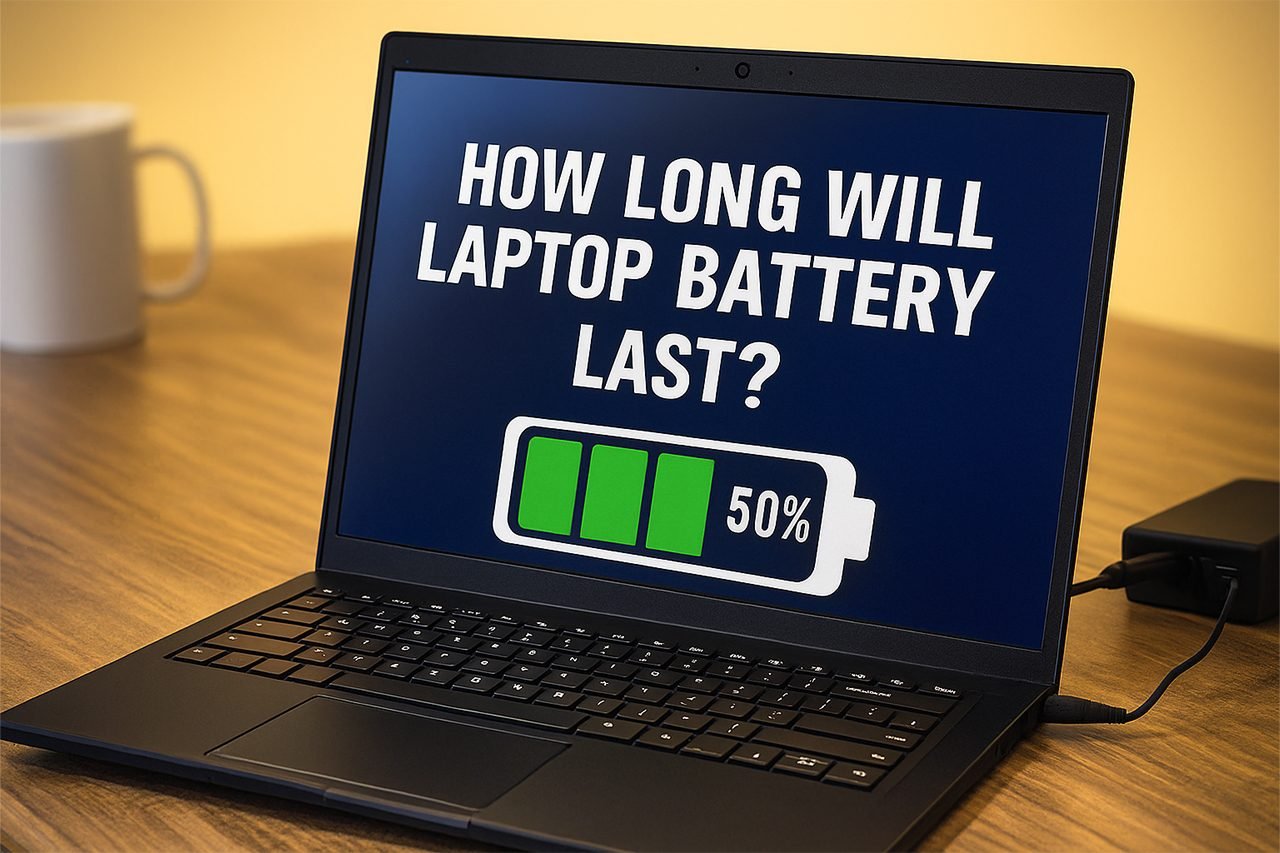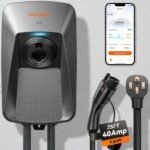Short answer:
- Per charge: Expect 4–12 hours for most modern laptops. Ultrabooks can hit 10–20 hours, gaming rigs often see 2–6 hours.
- Overall lifespan: Most laptop batteries keep useful capacity for 2–5 years or 300–1,000 full cycles, depending on care, heat, and workload.
This guide explains both meanings of battery life—how long a charge lasts and how many years the battery remains healthy—and gives you practical, test‑backed ways to estimate, measure, and extend both.
1) Two Meanings of “How Long Will It Last?”
When someone asks “How long will a laptop battery last?” they usually mean one of two things:
- Runtime per charge — How many hours do I get from 100% down to near empty?
- Lifespan over years — How many months/years before the battery loses too much capacity?
These are related but not the same. A laptop can last 12 hours per charge when new, yet after three years only last 6–8 hours because the battery has aged.
2) Quick Answer by Laptop Type
These are broad real‑world ranges with mixed usage (web, docs, some video), Wi‑Fi on, and moderate brightness.
- Ultrabooks / thin‑and‑light (13–14″): 10–20 hours when new. With heavy multitasking or high brightness, expect 7–12 hours.
- Productivity 15–16″ (integrated graphics): 6–12 hours typical. With power‑efficient CPUs and larger batteries, 8–15 hours is possible.
- Gaming / Creator (dGPU): 2–6 hours in mixed use. During gaming or GPU rendering, 1–3 hours is common.
- MacBook Air/Pro (Apple Silicon): 12–22 hours at light/medium workloads; 8–14 hours for heavier tasks.
- Chromebooks: 8–15 hours (light web‑first workloads, efficient OS).
Battery lifespan (years): With average care and room temps, expect 2–5 years of “good” health; with excellent care (and mild use), 4–7 years isn’t unusual. Heat, daily deep cycles, and high idle charge (100%) shorten this.
3) The Core Formula (and Worked Examples)
You can estimate runtime with a simple rule of thumb:
Runtime (hours) ≈ Battery Capacity (Wh) ÷ Average Power Draw (W)
- Battery capacity is measured in Watt‑hours (Wh). If you only see mAh and Volts (V), convert:
Wh = (mAh × V) ÷ 1000. - Average power draw (W) depends on your workload, screen brightness, refresh rate, CPU/GPU activity, apps, and peripherals.
Real‑World Examples
- Example A: Ultrabook — 58 Wh battery, light web/document use at ~7 W average →
58 ÷ 7 ≈ 8.3 hours. - Example B: Productivity 15″ — 70 Wh, moderate multitasking at 10–12 W →
70 ÷ 11 ≈ 6.3 hours. - Example C: Creator laptop (iGPU active) — 80 Wh, photo editing at 15 W →
80 ÷ 15 ≈ 5.3 hours. - Example D: Gaming laptop (dGPU idle/off) — 99 Wh, browsing at 12 W →
99 ÷ 12 ≈ 8.25 hours. - Example E: Gaming workload (dGPU on) — 99 Wh, game drawing 35–60 W →
99 ÷ 45 ≈ 2.2 hours(and <2 h for very demanding games).
How to Estimate Your Power Draw
- Windows: Check Settings → System → Power & battery for usage by app over time; use tools like HWInfo or your vendor’s utility to view package power. During light use, many efficient laptops idle around 3–8 W, mid‑load 10–20 W, heavy 30–60 W+.
- macOS: Activity Monitor → Energy shows energy impact. Under light use, Apple Silicon can idle extremely low; sustained compiles/exports spike draw.
- ChromeOS/Linux: Diagnostics (ChromeOS) or powertop/TLP (Linux) can hint at draw and wakeups.
Pro tip: Watch your average wattage over 10–15 minutes of your typical workflow. That’s the number to plug into the formula.
4) What Actually Drains Your Battery (Top Factors)
1) Display brightness & size
The screen is often the #1 draw. Bigger panels, higher brightness, and HDR consume more. A 16″ 120 Hz 4K panel at 80% brightness can pull several watts more than a 13″ 60 Hz panel at 40%.
2) Refresh rate (60 Hz vs. 120/144 Hz)
High refresh looks buttery but costs battery. Dropping from 120 Hz to 60 Hz can reclaim 0.5–2.0 W, adding 30–120+ minutes depending on your setup.
3) CPU architecture & load
Efficient cores and modern process nodes shine at light work. Background indexing, antivirus scans, and too many startup apps keep the CPU “awake” and waste power.
4) dGPU vs. iGPU
If the discrete GPU wakes for simple tasks (poor app optimizations, certain external displays), your draw can double or triple. Use the iGPU whenever you don’t need GPU muscle.
5) Wireless radios & connectivity
Wi‑Fi 6/6E is quite efficient, but flaky signals and constant large downloads increase draw. 4G/5G modems cost more battery than Wi‑Fi.
6) Storage & memory
Modern NVMe SSDs sleep quite low, but sustained read/write jobs (e.g., large project builds) bump draw. Excessive RAM‑hungry apps cause swapping and extra activity.
7) Peripherals & ports
USB bus‑powered drives, webcams, capture dongles, and high‑refresh external monitors all drink from the same battery.
8) Thermal conditions
Heat raises electrical resistance and degrades battery chemistry over time. Hot laptops throttle later but also waste energy via fans.
9) Battery wear
As the battery ages, its State of Health (SoH) drops, so the same workload yields fewer hours than when new.
5) How to Check Your Battery Health
Windows 10/11
- Press Win + X → Windows Terminal (Admin), then run:
powercfg /batteryreport - Open the HTML report it creates (usually in your user folder). Compare Design Capacity vs. Full Charge Capacity to see wear.
- In Settings → System → Power & battery, review Battery usage to spot power‑hungry apps.
macOS
- Click → System Settings → Battery for usage and Low Power Mode.
- For cycle count and health, open System Information → Hardware → Power. Check Cycle Count and Full Charge Capacity vs. Design Capacity.
ChromeOS
Open Diagnostics to view battery health and run tests; chrome://power can show power states.
Linux
Use upower -i /org/freedesktop/UPower/devices/battery_BAT0 or TLP reports (sudo tlp-stat -b) to view design vs. full capacity and cycle counts.
Healthy baseline: 100% when brand new. After ~1 year of normal use, 90–95% is common. Around 80% is a typical “replacement threshold” for many users.
6) How Long Until the Battery Wears Out? (Lifespan 101)
Laptop batteries are lithium‑ion (often Li‑poly packs) rated by cycles—one cycle is roughly using 100% of capacity in total (e.g., two 50% discharges = 1 cycle).
- Typical ratings: 300–1,000 cycles before capacity drops meaningfully (to ~80% of design). Many mainstream packs are in the 300–500 range; some premium designs aim for 800–1,000.
- In human terms: With one near‑full cycle per day, 300 cycles ≈ 10 months, 500 ≈ 1.5 years, 1,000 ≈ ~3 years. But most people do partial cycles and don’t discharge daily, so real‑world lifespan is often 2–5+ years.
Cycle Aging vs. Calendar Aging
- Cycle aging comes from charging/discharging.
- Calendar aging happens just sitting there—faster at high temperature and high state of charge (e.g., parked at 100% on a hot desk).
What Accelerates Wear
- Sustained heat (internal from CPU/GPU or external like car dashboards)
- Full charges to 100% all the time, especially when kept plugged in and warm
- Deep discharges to near‑0% frequently
- High‑power fast charging in hot environments
What Slows Wear
- Cool temps (but not freezing) and good ventilation
- Partial charges (e.g., keep between 20–80% when convenient)
- Vendor battery‑care modes that cap charge at 80–90% during desk work
- Gentle workloads that keep average draw (and heat) low
7) Charging Habits: What Helps vs. What’s Hype
Good habits that actually help:
- If you mostly use the laptop on a desk, enable battery‑care/charge‑limit modes (common on Lenovo, ASUS, Dell, HP, Apple’s Optimized Charging). Capping at 80–90% can materially slow aging.
- Avoid frequent deep discharges; try not to hit 0%.
- Keep it cool. Don’t block vents; avoid hot rooms and sunlit dashboards.
- Unplug during intense gaming/exports only if necessary—those loads create heat that’s hard on the pack. If you must use battery, elevate the laptop for airflow.
Habits that matter less than people think:
- Micro‑managing every percent. If charge‑limit tools are annoying, don’t stress—just avoid extremes.
- Monthly full discharge “calibration.” Modern laptops don’t need this for health; it’s only for recalibrating the gauge when readings seem off (do it sparingly).
Myth‑busting:
- “Keeping it plugged in will always kill it.” — Not if temperatures are low and charge‑limit/optimized charging is enabled. The enemy is heat + 100% SoC for months.
- “You must always charge to 100%.” — No. Partial charges are fine and can be healthier long‑term.
- “Fast charging ruins batteries.” — Modern packs are designed for it, but fast charging when hot hastens wear; let the laptop cool if possible.
8) OS‑Specific Tips: Windows, macOS, Linux, ChromeOS
Windows 11
- Power mode: Settings → System → Power & battery → Power mode → choose Best power efficiency on battery.
- Battery saver: Enable at 30–40% to curb background activity.
- Background/startup apps: Settings → Apps → Startup to disable non‑essentials. Less wake = more hours.
- Graphics selection: Settings → System → Display → Graphics to force apps to Power saving (iGPU) unless they need the dGPU.
- Refresh rate: Settings → System → Display → Advanced display → set 60 Hz on battery.
- Battery report:
powercfg /batteryreportfor health trends;powercfg /energyfor power drains. - Vendor tools: Lenovo Vantage, MyASUS, Dell Optimizer/Power Manager, HP Support Assistant often expose battery charge limits.
macOS (Apple Silicon & Intel)
- Low Power Mode: System Settings → Battery; optionally set for “On Battery” and “On Power Adapter”.
- Optimized Battery Charging: Keep it on—macOS learns patterns and avoids sitting at 100%.
- Cycle count & health: System Information → Power.
- App energy impact: Activity Monitor → Energy; Safari is typically efficient versus certain Chromium profiles.
- External displays: Some combos wake the dGPU (Intel models) or raise draw—prefer the built‑in display on battery.
Linux
- TLP: Install TLP for aggressive power tuning; defaults are sensible.
- powertop: Identify wakeups and set tunables to Good.
- GPU selection: Use PRIME/Wayland/iGPU‑only modes when possible.
ChromeOS
- Diagnostics app: Check health and run tests.
- Tab discipline: Many extensions/background tabs keep CPUs awake—trim them.
9) Display Tuning: Resolution, Brightness, and Refresh Rate
- Brightness: Every notch matters. Try 40–60% indoors; use auto‑brightness if it’s not over‑aggressive.
- Resolution scaling: Driving 4K at native on a 13–14″ panel rarely helps text clarity versus 1440p/1080p equivalents but costs power.
- Refresh rate: Set 60 Hz on battery. Many systems let you use 120 Hz on AC, 60 Hz on battery automatically.
- HDR: Gorgeous, but bumps power. Consider disabling on battery.
Big win: On a 16″ 120 Hz panel, moving to 60 Hz and dropping brightness from 80% to 50% can easily add 1–3 hours.
10) CPU & GPU: Efficiency Modes, iGPU vs. dGPU
- Efficiency modes: Modern CPUs have “balanced/efficiency” modes that slash watts at light and medium loads with minimal speed loss.
- iGPU first: Force browsers, office apps, and media players to the integrated GPU. Only let creative suites or games wake the dGPU.
- MUX switch / Advanced Optimus: If your laptop supports it, dynamic switching saves power on the go; use dGPU‑only only when plugged in and needed.
- Video playback: Prefer hardware‑accelerated codecs (e.g., HEVC/AV1) and native apps that support decoding on your iGPU.
11) Networking, Storage, and Peripherals
- Wi‑Fi: Stronger signal = less retransmit = lower power. Move closer to the router or use 5 GHz/6 GHz bands with good signal.
- Downloads & cloud sync: Pause heavy sync on battery. Large OneDrive/Drive re‑syncs can quietly chew through watts.
- Storage: NVMe is efficient at idle; sustained transfers raise draw. Schedule big copies/rsyncs for when plugged in.
- Peripherals: Unplug USB drives, capture cards, and dongles. External monitors (especially high refresh/4K) add meaningfully to draw.
12) Thermals: Why Heat Is the Silent Battery Killer
Batteries hate heat. Even 5–10°C hotter, for long stretches, ages cells faster. Practical tips:
- Keep vents clear; use a stand to improve airflow.
- Don’t leave a running laptop in a closed bag.
- Avoid using or charging on soft bedding; fans ingest fuzz, temps spike.
- In summer, consider a gentle cooling pad—not for performance, but to reduce average temps.
13) Traveling with Laptops: Power Banks, USB‑C PD & Airplane Rules
- USB‑C Power Delivery (PD): Match or exceed your laptop’s wattage (e.g., 65 W, 90 W, 140 W). Undersized chargers may hold battery at idle but won’t charge well under load.
- Power banks: Look for USB‑C PD and capacity in Wh. Airlines generally allow ≤100 Wh in carry‑on without approval; 100–160 Wh may need airline permission. (Batteries belong in carry‑on, not checked.)
- In‑flight outlets: Often limited; your 140 W beast may only maintain charge, not increase it, while working.
14) When to Calibrate, When to Replace (and Signs of Failure)
Calibrate (rarely) if the percentage jumps around or shuts off at 15–20%—do a gentle full cycle to retrain the gauge: charge to 100%, rest, discharge to ~5–10% under light use, recharge to full. Do this only when readings are clearly inaccurate.
Replace if:
- Full Charge Capacity ≤ 70–80% of design and it impacts your day.
- You notice rapid drop from, say, 30% to 0%, even after calibration.
- The battery is swollen (trackpad click feels stuck, chassis gaps appear) — stop using immediately and seek service.
- The system throttles or shuts down unexpectedly on battery even at high charge.
Replacement cost varies by brand and model (integrated packs cost more to service). Use authorized parts when possible.
15) FAQ: Direct, No‑Nonsense Answers
Q: Is it bad to leave my laptop plugged in all the time?
A: Not inherently. If your laptop stays cool and supports charge limits/optimized charging, staying plugged in is fine. The real risk is heat at 100% for months.
Q: Should I always charge to 100%?
A: No. For longevity, 40–80% is a great daily window when convenient. But charge fully before long flights or heavy days—battery exists to be used.
Q: How many hours should I expect from a gaming laptop?
A: 2–6 hours mixed use, 1–3 hours gaming. Keep the dGPU off on battery for non‑gaming.
Q: Do MacBooks really last longer?
A: Apple Silicon is very efficient at light/medium work, so runtime per charge can be excellent. Lifespan is still subject to heat and usage patterns like any lithium battery.
Q: Is fast charging safe?
A: Yes, within design limits. Avoid fast charging while hot and don’t cover vents.
Q: Will a higher‑Watt charger damage my laptop?
A: No. USB‑C PD negotiates power; the laptop only draws what it can use. Just ensure the charger is reputable.
Q: Do I need to fully discharge monthly?
A: Only if your percentage reading is inaccurate. It’s a gauge fix, not a health requirement.
Q: Can I use a phone charger?
A: Many phones top out at 18–30 W. Some ultrabooks will slow‑charge or maintain via 30 W, but heavier laptops need 65–140 W to charge under load.
Q: My battery went from 20% to 0% instantly—why?
A: The gauge is likely out of sync or the pack is worn. Try a gentle calibration once; if it persists, the battery may be near replacement.
16) Fast Checklist: Add Hours Today
- Set 60 Hz refresh on battery; disable HDR.
- Drop brightness to 40–60%; enable auto‑brightness if reliable.
- Force common apps to the iGPU; reserve dGPU for creative apps/games.
- Turn on Battery Saver/Low Power Mode.
- Trim startup/background apps; pause cloud sync on battery.
- Unplug bus‑powered USB devices and avoid external 4K/144 Hz displays on battery.
- Keep the laptop cool; raise the rear for airflow.
- Enable charge limit/optimized charging when desk‑bound.
17) Make Your Own Estimate: A Simple Worksheet
Use this quick worksheet to estimate your runtime today and post‑degradation.
Step 1 — Find your battery capacity (Wh).
- Windows:
powercfg /batteryreport→ Design Capacity / Full Charge Capacity - macOS: System Information → Power → Full Charge Capacity
Step 2 — Measure your typical power draw (W).
- Work as you normally do for 10–15 minutes. Use a tool (HWInfo, vendor utility, Activity Monitor’s energy impact as a proxy) to observe average draw.
Step 3 — Calculate runtime.Runtime (h) ≈ Full Charge Capacity (Wh) ÷ Average Draw (W)
Step 4 — Sanity‑check scenarios.
- Light day (email/docs/web, 60% brightness, 60 Hz): 6–10 W
- Moderate day (Slack + docs + some calls, 70% brightness, a few big downloads): 10–18 W
- Heavy day (compiles/exports, lots of external storage, high brightness): 20–45 W
Step 5 — Age it forward.
- New battery at 100% SoH: use full capacity in Wh.
- After 1–2 years (85–90% SoH): multiply capacity by 0.85–0.9.
- After 3–4 years (70–80% SoH): multiply by 0.7–0.8.
Example:
- Full charge capacity 58 Wh, measured draw 9 W →
58 ÷ 9 ≈ 6.4 hourstoday. - After 2 years at 85% SoH →
58 × 0.85 = 49.3 Wh,49.3 ÷ 9 ≈ 5.5 hours. - After 4 years at 75% SoH →
58 × 0.75 = 43.5 Wh,43.5 ÷ 9 ≈ 4.8 hours.
Putting It All Together (Practical Summary)
- Per charge depends mostly on screen, CPU/GPU activity, and background tasks. Use the Wh/W formula to get a realistic number for your workflow.
- Lifespan in years depends on cycles, heat, and how often you sit at 100%. Use charge‑limit modes, keep temps down, and avoid deep discharges when feasible.
- You don’t need to micromanage. Focus on big wins (brightness, refresh rate, iGPU, background app hygiene) and cool temperatures.
If you adopt even half the tips in this guide, you’ll typically gain 1–4 hours per charge and add **months—sometimes years—**to your battery’s useful life.
Glossary (Quick Reference)
- Wh (Watt‑hour): Total energy the battery can hold. Higher Wh = longer potential runtime.
- W (Watt): Instantaneous power draw. Lower W = slower drain.
- SoH (State of Health): Battery health as % of design capacity.
- Cycle: Roughly 100% of charge used (not necessarily one full 0→100→0).
- iGPU/dGPU: Integrated vs. discrete GPU. iGPU sips power; dGPU gulps.
- USB‑C PD: Power Delivery fast‑charging standard. Needs enough Watts to charge while working.
Editor’s Note for Power Users (Optional Tweaks)
- Undervolting/advanced tuning: Can save a few watts but is model‑specific; stability and warranty risks apply.
- Battery charge ceilings: Some BIOS/UEFI let you hard‑cap at 80%. Great for desk use.
- AV1/HEVC decode: Choose media/players that use hardware decode paths to save battery during long flights.
Final Word
Batteries are consumables—but you control the slope of the curve. Know your Wh, watch your W, keep it cool, and your laptop will last longer per charge and per year.











